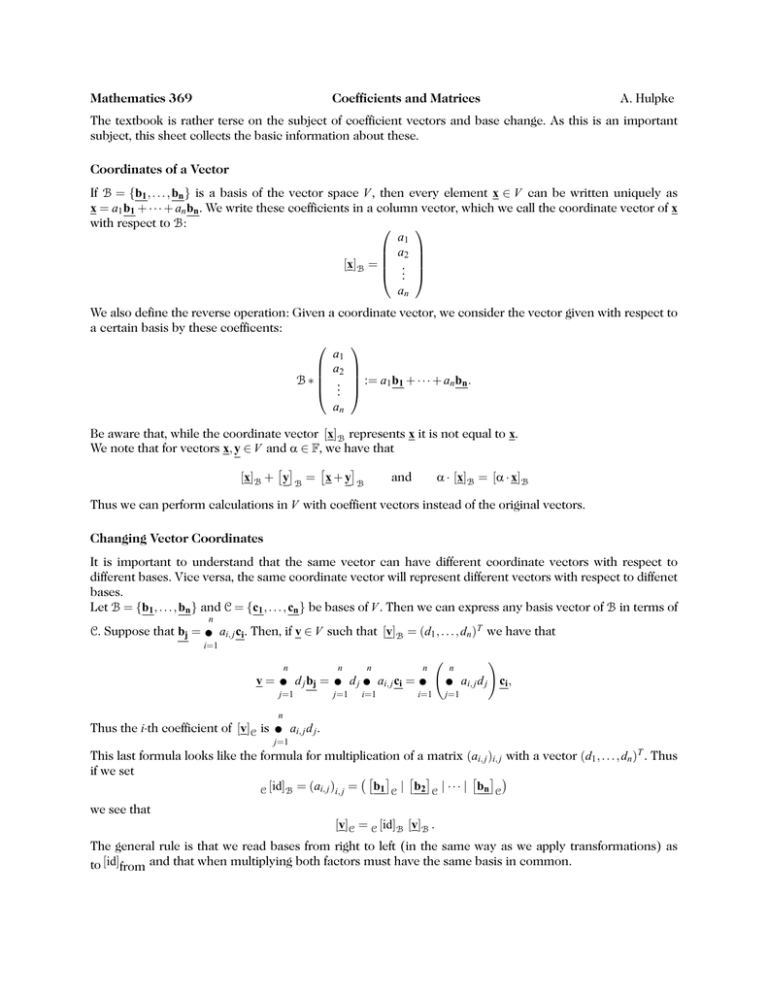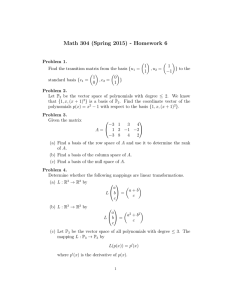Mathematics 369 Coefficients and Matrices A. Hulpke
advertisement

Mathematics 369
Coefficients and Matrices
A. Hulpke
The textbook is rather terse on the subject of coefficient vectors and base change. As this is an important
subject, this sheet collects the basic information about these.
Coordinates of a Vector
If B = {b1 , . . . , bn } is a basis of the vector space V , then every element x ∈ V can be written uniquely as
x = a1 b1 + · · · + an bn . We write these coefficients in a column vector, which we call the coordinate vector of x
with respect to B:
a1
a2
[x]B = .
..
an
We also define the reverse operation: Given a coordinate vector, we consider the vector given with respect to
a certain basis by these coefficents:
a1
a2
B ∗ . := a1 b1 + · · · + an bn .
..
an
Be aware that, while the coordinate vector [x]B represents x it is not equal to x.
We note that for vectors x, y ∈ V and α ∈ F, we have that
[x]B + y B = x + y B
and
α · [x]B = [α · x]B
Thus we can perform calculations in V with coeffient vectors instead of the original vectors.
Changing Vector Coordinates
It is important to understand that the same vector can have different coordinate vectors with respect to
different bases. Vice versa, the same coordinate vector will represent different vectors with respect to diffenet
bases.
Let B = {b1 , . . . , bn } and C = {c1 , . . . , cn } be bases of V . Then we can express any basis vector of B in terms of
n
C. Suppose that bj = ∑ ai, j ci . Then, if v ∈ V such that [v]B = (d1 , . . . , dn )T we have that
i=1
v=
n
n
n
n
n
j=1
j=1
i=1
i=1
j=1
∑ d j bj = ∑ d j ∑ ai, j ci = ∑ ∑ ai, j d j
!
ci ,
n
Thus the i-th coefficient of [v]C is
∑ ai, j d j .
j=1
This last formula looks like the formula for multiplication of a matrix (ai, j )i, j with a vector (d1 , . . . , dn )T . Thus
if we set
b1 C | b2 C | · · · | bn C
C [id]B = (ai, j )i, j =
we see that
[v]C = C [id]B [v]B .
The general rule is that we read bases from right to left (in the same way as we apply transformations) as
to [id]from and that when multiplying both factors must have the same basis in common.
This formula generalizes easily to multiple base changes. If B, C and D are bases we have that
D [id]B ·
[v]B = [v]D = D [id]C · [v]C = D [id]C · (C [id]B · [v]B ) = (D [id]C · C [id]B ) · [v]B
As we can have any column vector for [v]B , we get that
D [id]B
= D [id]C · C [id]B
Clearly B [id]B is the identity matrix. Thus we get that C [id]B is invertible and
−1
C [id]B
= B [id]C
Matrices for linear transformations
The situation with matrices for linear transformations is rather similar:
Suppose that T : U → V is a linear transformation and that B = {b1 , . . . , bn } is a basis of U and C = {c1 , . . . , cm }
a basis of V .
h
i
If T (bj ) = a1 j c1 + a2 j c2 + · · · + am j cm , then T (bj ) = (a1 j , a2 j , . . . , am j )T . We thus set
C
a11
a21
.
C [T ]B =
..
am1
a12
a22
..
.
···
···
..
.
a1n
a2n
..
.
am2
···
amn
= T (b1 ) C | T (b2 ) C | · · · | T (bn ) C
and get that for each x ∈ U the action of T is given by matrix multiplication with the coordinate vector
[T (x)]C = C [T ]B [x]B
(The situation of a base change thus is a special case for the linear transformation id which maps every vector
to itself.)
If T : U → U and only one basis is involved, we might use [T ]B to denote the (necessarily quadratic)
coordinate matrix B [T ]B .
Describing Linear Transformations by matrices
Let U be an n-dimensional vector space and V an m-dimensional vector space. Suppose that A ∈ Fm×n . For
every choice of bases B of U and C of V we can interpret A as matrix for a linear transformation T : U → V ,
such that A = C [T ]B : Simply define
T (x) = C ∗ (A [x]B )
(A different choice of bases will yield different transformations.)
Base change for linear transformation
If T is a linear transformation given by C [T ]B we can obtain a matrix with respect to different bases by
multiplying with the appropriate base change matrices in the same way as above::
E [T ]D
= E [id]C C [T ]B B [id]D
In particular, if we set C = B and E = D, we get that
[T ]D D [T ]D = D [id]B B [T ]B B [id]D = Q−1 B [T ]B Q where Q = B [id]D
and
[T ]B B [T ]B = B [id]D D [T ]D D [id]B = P−1 D [T ]B P where P = B [id]D = Q−1


